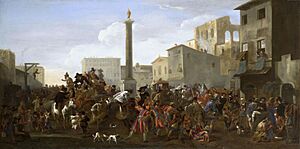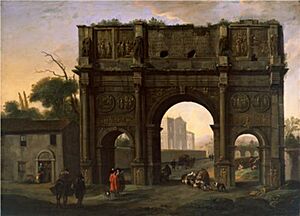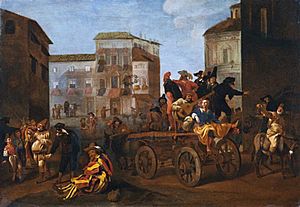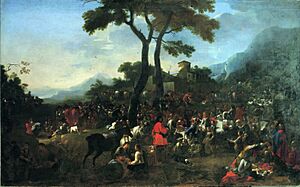Jan Miel facts for kids
Jan Miel (born 1599 in Beveren-Waas, died April 1664 in Turin) was a Flemish painter and engraver who worked mostly in Italy. He was first part of a group of Dutch and Flemish painters in Rome called the 'Bamboccianti'. These artists were known for painting scenes of everyday life, especially showing ordinary people in Rome. Later, he changed his style and started painting history subjects in a more classical way.
Jan Miel worked with many other artists in Rome. Towards the end of his career, he moved to Turin and became the official court painter for Charles Emanuel II, who was the Duke of Savoy.
Contents
Life of Jan Miel
Jan Miel was probably born in Beveren-Waas, a town in Flanders. We don't know much about his early art training, but it's thought he learned in Antwerp. An old Italian writer named Giovanni Battista Passeri said Miel trained with the famous painter Anthony van Dyck, but there's no clear proof of this.
Miel lived in Rome from at least 1636 to 1658, but he might have arrived as early as 1633. In Rome, he joined a group of mostly Dutch and Flemish artists called the Bentvueghels. It was a tradition for this group to give each member a fun nickname. Jan Miel had two nicknames: Bieco (which means 'squint' in Italian) and Honingh-Bie (which means 'honey bee'). This second name came from 'Miele', the Italian word for 'honey', which was how people knew him in Italy.
In Rome, Miel also became connected to the 'Bamboccianti' painters. Their art was inspired by the Dutch painter Pieter van Laer. The Bamboccianti were mainly Dutch and Flemish artists in Rome who painted small pictures or made prints. Their works showed the daily lives of ordinary people in Rome and the countryside. Jan Miel was very important in developing this new style in Rome.
In 1648, Miel became the first artist from northern Europe to be accepted into the Accademia di San Luca. This was a very important art academy for leading artists in Rome. Around 1654, Miel spent some time in Northern Italy. From 1658 until he died, he lived in Turin. There, he was chosen to be the court painter for Charles Emanuel II, the Duke of Savoy. On December 5, 1663, two artists, Willem Schellinks and Jacques Thierry, visited Jan Miel in Turin. Schellinks wrote in his journal that the Duke had given Miel the "Knightly Order of St Maurice and Lazarus," which was a special honor.
Jan Miel's Artworks
Early Paintings
Jan Miel's first paintings from the 1630s already show the influence of Pieter van Laer and the Bamboccianti style. They often show ordinary people doing their daily activities or playing games. Some popular subjects he painted included people playing the game of morra, gamblers, village dances, traveling doctors (quacks), barbers, shoemakers, and street musicians or actors. Examples of his early works in this style include The bowls players and The cobbler, both painted in 1633. During this time, he also copied and changed paintings by van Laer.
An example of his 'bambocciate' style is The quack (Hermitage Museum, 1650s). This painting shows a traveling medicine seller with his helpers, demonstrating his products to a crowd. The idea of 'quacks' was common in Flemish and Dutch paintings from the 1500s onwards. For example, in the 1500s, Jan Sanders van Hemessen painted The Surgeon, which showed a fake surgeon pretending to remove a 'stone of madness' from someone's head. Later, artists like Adriaen Brouwer and Jan Steen also painted this theme. In Miel's The quack, the main characters are dressed like figures from the commedia dell'arte, which was a type of Italian comedy theater. The quack wears the mask and costume of Il Dottore, and the guitar player is dressed as a Zanni (a funny servant). Jan Miel painted other works with commedia dell'arte characters, such as Carnival in Rome (Prado Museum, 1653) and The Actors' Rehearsal.
During the 1640s and 1650s, Miel, like another artist named Michelangelo Cerquozzi, started to focus less on the landscape in his bambocciate paintings. Instead, he emphasized the interesting stories and details of city and country life. These works were often used as examples by other Bamboccianti painters later on.
Miel made his most unique contribution to this type of painting through his scenes of carnival celebrations. An example is Carnival on the Piazza Colonna (Wadsworth Atheneum, 1645). This painting powerfully shows the excitement of carnival. As is typical in Miel's 'bambocciate' paintings, both rich and ordinary people appear in the same scene. Roman nobles on horseback wear fancy costumes, while common people fill the square, having fun, asking for money, playing games, and doing other everyday activities. A group of commedia dell'arte actors on a cart also joins the celebration. The fun happens on the last day of Carnival when everyone is most excited. Since Carnival also marks the start of spring, a figure representing winter hangs from a gallows on the left side of the painting.
Working with Other Artists
Jan Miel often worked with other artists, which was common at the time. He painted the people (called 'staffage') in the vedute (cityscapes or views) by artists like Viviano Codazzi and Alessandro Salucci. He also added figures to the landscapes of Gaspard Dughet and Angeluccio.
Miel worked especially closely with Alessandro Salucci, who was important in developing veduta painting. Salucci created many capricci, which are paintings that combine real Roman monuments with imaginary backgrounds. Their teamwork started in 1635 and continued until Miel left Rome for Turin in 1658. One painting from their collaboration, Imaginary Seaport (Cincinnati Art Museum), is dated 1656. Miel was very good at painting stories and filling the empty spaces in Salucci's detailed city views. Miel often included several small story scenes in one artwork. For example, in An architectural capriccio with an ionic portico, a fountain, a two-story loggia, a Gothic palace and figures on a quay, you can see different groups of people doing their own things: an elegant couple on the stairs, people at a well, and card players in the distance. Miel's figures were usually farmers, beggars, people playing morra, innkeepers, and porters. He often mixed them with elegantly dressed men and women, which added a lively feel of Roman daily life to Salucci's architectural scenes.
There is a record from 1641 that Jan Miel was in the studio of Andrea Sacchi. This was quite unusual because Sacchi was known for criticizing the Bambocciante style, which Miel was famous for. This time in Sacchi's studio might have helped Miel move towards a more grand and classical style of painting. Miel worked with Andrea Sacchi on the painting Urban VIII visits the Church of the Gesù (Galleria Barberini, Rome, 1641). It's thought that Sacchi painted only a small part of it himself, and Jan Miel painted the figures in the front based on Sacchi's drawings.
Old art records also mentioned that Miel added figures to the landscapes of Claude Lorrain when he was in Rome. However, it has been difficult to confirm that the human figures in Lorrain's works were indeed painted by Miel.
Later Style Changes
Around 1650, Jan Miel started painting fewer bambocciate scenes. He began to focus more on large religious paintings for churches in Rome. Several works from the 1650s show this more serious style, such as an altarpiece called The Madonna and Child with Saints in the Duomo di Santa Maria della Scala in Chieri, painted in 1651. At the same time, Miel also created smaller religious paintings. Important families in Rome, like the Barberini family, ordered these works from him. His art also started to show a move towards classicism, which means a style inspired by ancient Greek and Roman art. His painting Dido and Aeneas is an example of this.
After moving to Turin in 1658, he decorated the royal hunting lodge at Venaria Reale with large paintings of hunting scenes. Some of these parts are now lost. He painted more and more history paintings, which showed an even stronger classical style, similar to what was already seen in his religious paintings from the 1650s. Miel also began to study and copy the works of famous artists like Raphael and Annibale Carracci, just as he had copied Pieter van Laer's works earlier in his career.
Prints and Engravings
Jan Miel was also a skilled engraver. He designed the front page for a book called La povertà contenta (Rome, 1650) by Daniello Bartoli. He also created the pictures for another book, De bello belgico (Rome, 1647) by Famiano Strada.
Images for kids
See also
 In Spanish: Jan Miel para niños
In Spanish: Jan Miel para niños










